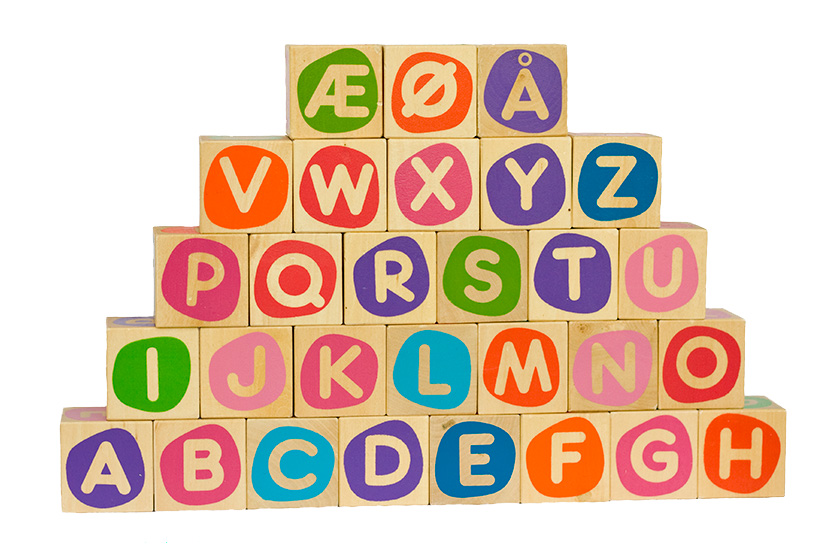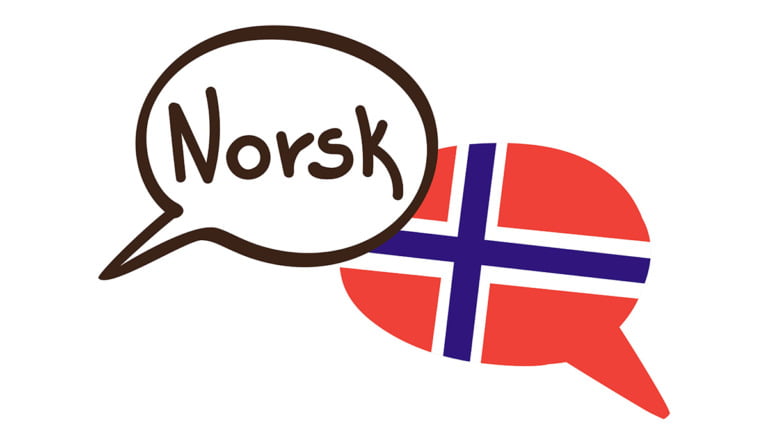Word order is a tricky thing to get to grips with when learning any language. Norwegian has a particular quirk shared with many Germanic languages. Here's what you need to know about the V2 rule.
The Norwegian language has some peculiarities, and the V2 rule is one of them. As the Norwegians themselves say, it’s all about ordstilling (word order).

So, whether you’re in the process of learning Norwegian or just want to hear about one of that language's many quirks, join us as we dive into the strange and wonderful world of Norwegian grammar.
A Germanic phenomenon
The V2 rule is not unique to Norwegian. In fact, it applies in almost all the Germanic languages. You'll find it in Swedish, Danish, Icelandic, Faroese, German (obviously) and Dutch.
Weirdly—but not unexpectedly, since we're writing this article—it doesn't exist in English.
Why V2 is important
Respecting the V2 rule is important because it's one of those things that comes naturally to native speakers. Not respecting the rule immediately identifies you as a foreigner.
Learn Norwegian Now: Norwegian Class 101 / The Mystery of Nils
If you're learning Norwegian, and if it's your first time learning a foreign language, you may easily fall into a common language learner's trap.

This trap is to question the logic of the language you're learning. Some may even refuse certain “illogical” rules and persist in not learning them.
Questioning the logic of a language is tempting. After all, if you translate Norwegian sentences literally, they do sound a bit silly in English. Why are the rules what they are? Who decided this? Why doesn't it make any sense?
If you think about it, English doesn't make much sense either. Through, though and thought don't rhyme, despite being almost the same word (at least in the way they are written).
Questioning the logic of a language you are learning is about as productive as questioning the order of the alphabet. You just have to accept that the language exists as it is, that it's not always based on pure logic, and move on. Not doing so will greatly impede your progress.
The V2 rule explained
The V2 rule dictates that the verb must come in the second grammatical place in the sentence. This is applied pretty much always, although as with all language rules there are exceptions.

The rule is best explained with examples.
Subject-verb-object
Let's say that you want to tell your friend that you made dinner. In English, you'll say: I made dinner. The sentence is structured in a very familiar subject (I), verb (made) object (dinner) order.
In Norwegian, the sentence follows the same subject-verb-object structure: “Jeg laget middag” (where jeg means “I”, laget means “made” and middag means “dinner”.
So far so good, right? The verb takes second place. Complicate the sentence a bit more, though, and that's when things start getting weird.
Where V2 comes into play
Suppose you want to specify that you made dinner yesterday. In English, you will say: Yesterday, I made dinner. The V2 rule prohibits you from following the same word order in Norwegian.
The correct way to compose that sentence in Norwegian is “I går laget jeg middag”. Literally, that translates as “Yesterday made I dinner”.
You'll see that the subject and verb are reversed, to ensure the verb takes the second position in the sentence. Note that this isn't always the same thing as the second word. In this case, “i går” means “yesterday” and takes the first grammatical place as an adverb. “laget” takes position two as the verb, meaning the subject “jeg” must come third.

If you say the sentence in Norwegian with the normal English word order “I går jeg laget middag”, people will immediately know that you're not Norwegian.
What if you want to have “yesterday” at the end of the sentence, I hear you ask. Is that allowed? It is! But the V2 rule still must be respected.
“I made dinner yesterday” becomes “Jeg laget middag i går”. Did you notice anything? The word order is the same as in English. Because the verb comes second, V2 is respected and the sentence sounds more “normal” to an English speaker's ears.
A few more examples
- First, we will go to the airport: Først skal vi til flyplassen (and not “Først vi skal til flyplassen”).
- On Christmas Eve, we eat turkey: På julaften spiser vi kalkun (and not “På julaften vi spiser kalkun”).
- Tomorrow, I will fix the car: I morgen skal jeg fikse bilen (and not “I morgen jeg skal fikse bilen”).
But what about questions?
One of the confusing aspects of the V2 rule for native English speakers is that it makes sentences sound a bit like questions. How can you tell then if a sentence is a question?

Here's an example of this ambiguity:
Yesterday, you were tired: I går var du trøtt. The word order in Norwegian is “Yesterday were you tired”. It does sound exactly like a question. And confusingly, “Var du trøtt?” is exactly how you would ask a Norwegian if they were tired.
How can you tell if it's a declaration or a question? There are two ways: first, if Norwegians put the “yesterday” at the end and say “Var du trøtt i går?” there is no ambiguity. It's definitely a question. More often than not, that's how they'll phrase the question.
They can still phrase it the other way though, with “yesterday” at the start. Did the Norwegian declare “I går, var du trøtt!” (Yesterday, you were tired!) or did they ask “I går, var du trøtt?” (Yesterday, were you tired?).
In that example you have to rely on both the tone of the sentence (if it sounds like a question) and on the pause between “I går” and the rest of the sentence. The pause is likely to be longer if the sentence is meant to be a question.
The difficulty of explaining your own language
Another thing that makes the V2 rule difficult is that it's really not easy to explain, for a Norwegian. Think about it: when you grow up with a certain grammatical structure, it just feels normal and natural, and you don't question why things are the way they are.
Learn Norwegian Now: Norwegian Class 101 / The Mystery of Nils
So, while a Norwegian may correct you if you make a V2 mistake, they may not be able to explain to you why what you said was wrong. It's entirely possible that they've never heard about the V2 rule. They simply follow it intuitively.
If that's difficult to understand, flip the situation the other way around. How would you explain to a Norwegian that it is incorrect to say “Yesterday made I dinner”?
Tell us what you think
Are you learning Norwegian? Do you struggle with the V2 rule? Are there any other peculiarities of the Norwegian language that make your life difficult? Tell us in the comments!


I found this very very useful! I having been learning Norwegian, I’m hopes to work here one day as a nurse! Something I think I struggle with is some of the pronunciations…especially the “r”s!
Glad to know it helped 🙂 Pronounciation of the “r” sound is always tricky for native English speakers, so you’re not alone.
I JUST learned about this in my Norwegian language class yesterday! Extremely helpful!
Glad I could help 😇
how would the sentences “what do wolves eat?” and “what eats wolves?” be structured in norwegian?
I would say “Hva spiser ulven” for the first one and “Hva blir ulver spist av” for the second one (literally: what /become/ wolves eaten by)
Actually, in Norwegian, «Hva spiser ulver?» can mean both «What do wolves eat?» and «What eats wolves?», so there is an ambiguity. However, common sense would lead people to assume the first meaning. (Saying «What eats wolves?» instead of «What do wolves eat?» sounds like a beginner’s mistake a Norwegian could make when learning English).
If you wanted to make it completely unambiguous, you could say «Hva er det ulver spiser?» (What is it that wolves eat?) or «Hva er det som spiser ulver?» (What is it that eats wolves?).
Hei thank you for this article, I came across a question on Reddit and discovered V2 rule and further digging brought me to your article and it just clarifies things!
How would ‘many dogs drink milk’ be structured i Norwegian?
“Mange hunder drikker melk” – same structure as in English 👍
Hi, Daniel, thanks for the article.
I often meet this kind of structure: Det melder den russiske nettavisen Novaja Gazeta. (The Russian online newspaper Novaya Gazeta reports it) I would like to know if this sentence is still correct if I change it to: Den russiske nettavisen Novaja Gazeta melder det.
If so, why put the object at the beginning of the sentence?
Tusen takk.
Hi Winston,
Your version is correct, but in the context of the original sentence it would sound unusual. This is because your original sentence almost certainly came after a previous statement. The second sentence (the one you quote) merely attributes the statement. So the object comes first for emphasis.
The same way “I said that” and “That’s what I said” are both correct, but the latter has a different emphasis.
Hope that helps.
Hi! Thank you so much. This helped a lot. A few months ago, I figured out that I was part Norwegian so I am hoping to visit one day. I just have one question. For the example, “On Christmas Eve, we eat turkey.” Would it be “On eat, Christmas Eve we turkey.” Or “On Christmas Eve, eat we turkey.”?
PS I am only in fourth grade so if any of my grammar os spelling is incorrect please don’t judge.
Thank you, in advance
That would be “On Christmas Eve eat we turkey” 🙂
Kudos on getting interested in a foreign language at such a young age. Good luck!
That is easy enough. But why is the V2 rule not working in so many cases?
I gor var det kald, så jeg tok en buss til jobb (or “tok jeg???)
Jeg tok en buss til jobb, fordi det var kaldt (or “var det kaldt”)?
The V2 rule applies in both of your examples. The second half of each sentence is a subordinate clause (a kind of subsentence that can’t stand on its own). The words “så” and “fordi” act as conjunctions, so they don’t really “count”, so to speak. But look at what happens if we start with the subordinate clause:
Fordi det var så kaldt tok jeg en buss til jobb.
The subordinate clause “fordi det var så kaldt” takes the first spot, so we have to start the main clause with the verb to respect V2.
I’ve been studying Norwegian off and on for several years now and recently began using a native language exchange app to talk with natives and learn from them directly. In doing so, I encountered the sentence “Så kul genser du har” and was informed that “Så kul genser har du” would be incorrect here. Similarly, the sentence “Du spiser så krydret måltid” could validly be restructured as “Så krydret måltid du spiser”, but not “Så krydret måltid spiser du”. What is the reason for this apparent V2 rule violation? Does this work with every sentence that includes direct object?
Takk,
Iulia
Hallo,
I’ve been learning Norsk with DuoLingo for about a week now and I’m really enjoying it. It started out really easy with simple phrases like “Kaffe og melk, takk.” But I hit my first really frustrating hurdle when I got to “how are you?,” “are you alright?,” “how’s it going?,” etc. I was definitely making the mistake of trying to apply English logic to a Germanic language. I realize that there are instances in every language where you just have to remember the word order whether it makes sense or not; but it’s frustrating.
Hi Daniel
Thank you for your useful article. I’m still struggling with when to use the V2 rule. I used an online translator to translate, “It doesn’t snow much where I live” and it has given me, “Det snør ikke mye der jeg bor”. I would have expected it be “der bor jeg” following the V2 rule. Did the online translator get it wrong, or is there a reason why the V2 rule hasn’t been followed?
Also, is it always “der” instead of “hvor” when it’s a statement of where something is instead of a question.
Tusen takk
Hi there 🙂 The online translator is correct. I don’t have a grammar degree so my terminology might be a bit inaccurate when answering, but in your sentence, “der jeg bor” is the object of the sentence. It’s not a separate clause. Just like “where I live” is not a separate clause in the original English version.
If you split your sentence in two however: “Det snør ikke mye. Der bor jeg.”, then V2 applies. This of course alters the meaning. It would translate in English as “It doesn’t snow much. That’s where I live.” (The two are unrelated, as if you’re driving around commenting the weather and then pointing out the place where you live).
About your second question, off the top of my head I would say that you are correct. “Hvor” is for questions and “der” for statements. Of course I only need to say this for someome to come up with a counterexample so let’s wait 🙂 But we can safely say that your interpretation is correct in most cases.
Thanks for a very good article!
Just a small detail related to one of the examples:
The clause “I går, var du trøtt!” should have no comma.
There is no pause between the time adverbial (I går) and the verbal (var) in a clause like this, in the same way as for an SVO structure. So the correct thing is:
“I går, var du trøtt!” / “Du var trøtt i går!”